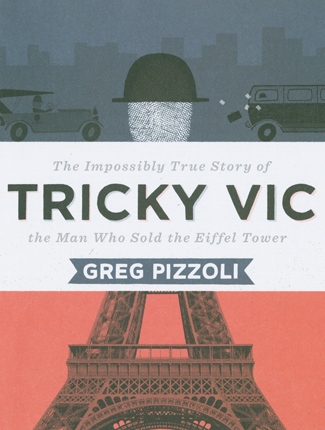| Tricky Vic : the impossibly true story of the man who sold the Eiffel Tower Author: Pizzoli, Greg | ||
| Price: $6.50 | ||
Summary:
The true story of one of Europe's most notorious con artists.
| Accelerated Reader Information: Interest Level: MG Reading Level: 7.00 Points: .5 Quiz: 172595 | Reading Counts Information: Interest Level: 3-5 Reading Level: 12.70 Points: 3.0 Quiz: 66043 | |
Reviews:
Kirkus Reviews (+) (12/15/14)
School Library Journal (12/01/14)
Booklist (01/01/15)
The Bulletin of the Center for Children's Books (+) (04/15)
The Hornbook (00/05/15)
Full Text Reviews:
School Library Journal - 12/01/2014 Gr 3–6—This picture book takes a look at Robert Miller, a successful con man who managed to dupe many and by posing as a government official was even able to "sell" the Eiffel Tower to scrap metal dealers, before being caught and imprisoned. Miller used more than 45 aliases during his life but was known to many as Tricky Vic. This is a fascinating story, with quirky, retro-style, mixed-media art that will appeal to readers. Beyond a line or two at the beginning about Vic turning to a life of crime, Pizzoli doesn't moralize about his subject's actions. Tricky Vic is a little-known subject, and some may wonder if there's an audience for this title. However, this is an intriguing account, and through sidebars, the book offers some effective avenues for discussing related historical events, people, and places, such as Al Capone, Prohibition, counterfeiting, and Alcatraz. An attractive, though esoteric, offering.—Dorcas Hand, Annunciation Orthodox School, Houston, TX - Copyright 2014 Publishers Weekly, Library Journal and/or School Library Journal used with permission.
Booklist - 01/01/2015 Tricky Vic started out as an intelligent kid in what is now the Czech Republic, but he went on to become a notorious swindler. Adopting the name Count Victor Lustig, he used his sophisticated demeanor to earn the trust of wealthy passengers on transatlantic cruises and rob them blind. He made counterfeit money and tricked hapless dupes into buying a money-making machine (merely a fancy box with some dials on the outside). He even conned Al Capone! Selling the Eiffel Tower (to scrap dealers) is by far the most enticing of his crimes, and he did it more than once. Pizzoli puts the larger-than-life stories in a tidy format, placing short, engaging paragraphs on colorful pages with informative sidebars to explain historical context. His blocky mixed-media illustrations include photos and clever cartoonish figures—the unfortunate fellow who bought the Eiffel Tower, Mr. Poisson, has a fish for a head, and Tricky Vic’s face is obscured by a fingerprint. Elementary-school kids impressed by brazen acts of skulduggery will be snowed by this well-told true story. - Copyright 2015 Booklist.
Bulletin for the Center... - 04/01/2015 Evidently “Go big or go home” applies to crime as well as sports, and it could be an apt mantra for Robert Miller, alias Count Victor Lustig, an early twentieth century swindler whose cons grew to monumental proportions. Pizzoli’s short and stylish account follows Miller from his early years as a gifted student and gambler, who finds a way to put his multilingual skills, good looks, and polished demeanor to lucrative, if risky, use. First, he bilks ocean-liner passengers out of their money, comes to America and cons Al Capone into blessing his game, and then ups the ante with the Romanian Money Box con, an oldie but goodie that lets the perp slip out of town before the mark finds himself stuck with nothing. The acme of Lustig’s career, though, was convincing contractors to bid on demolishing Paris’s aging and decrepit Eiffel Tower and selling the valuable iron for scrap-award going to the gullible high bidder and cash going into Lustig’s pocket. Yes, he got his comeuppance and spent his final days in federal prison-but what a fabulous story he left behind. Pizzoli nimbly walks the line between censure of Lustig’s crime and utter delight in his cleverness and boldness. The picture-book format-a mash-up of retro-styled cartooning and period reproduction vignettes, with our bowler-hatted anti-hero portrayed with a pixelated fingerprint for a face-works wonderfully. Sidebars supplement the text, and visual gags complement the wry tone, with would-be buyer Mr. Poisson depicted with a fish head, and another mark helpfully sporting a name tag, “Hello, my name is Mark.” A glossary, selected sources, and an author’s note are included, and Pizzoli clarifies how he dealt with shaky information. After all, “I wouldn’t want you to feel as though you’ve been conned.” EB - Copyright 2015 The Board of Trustees of the University of Illinois.



